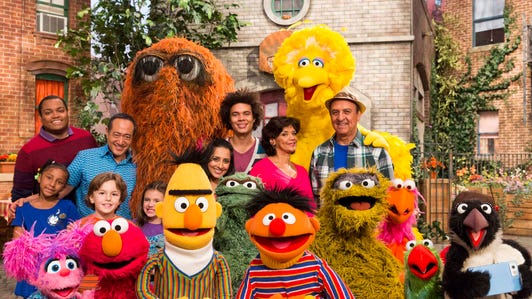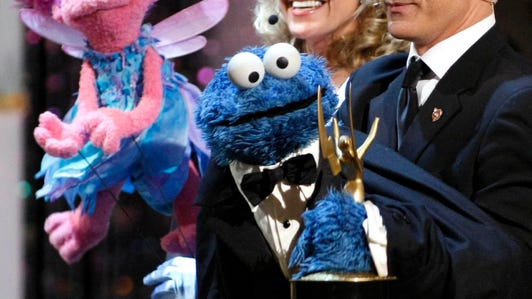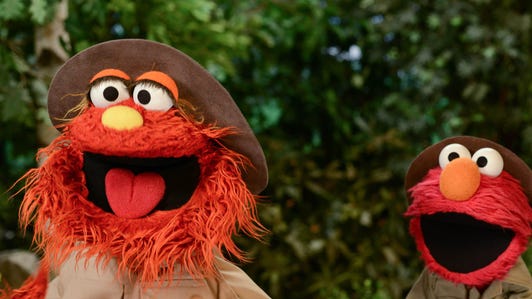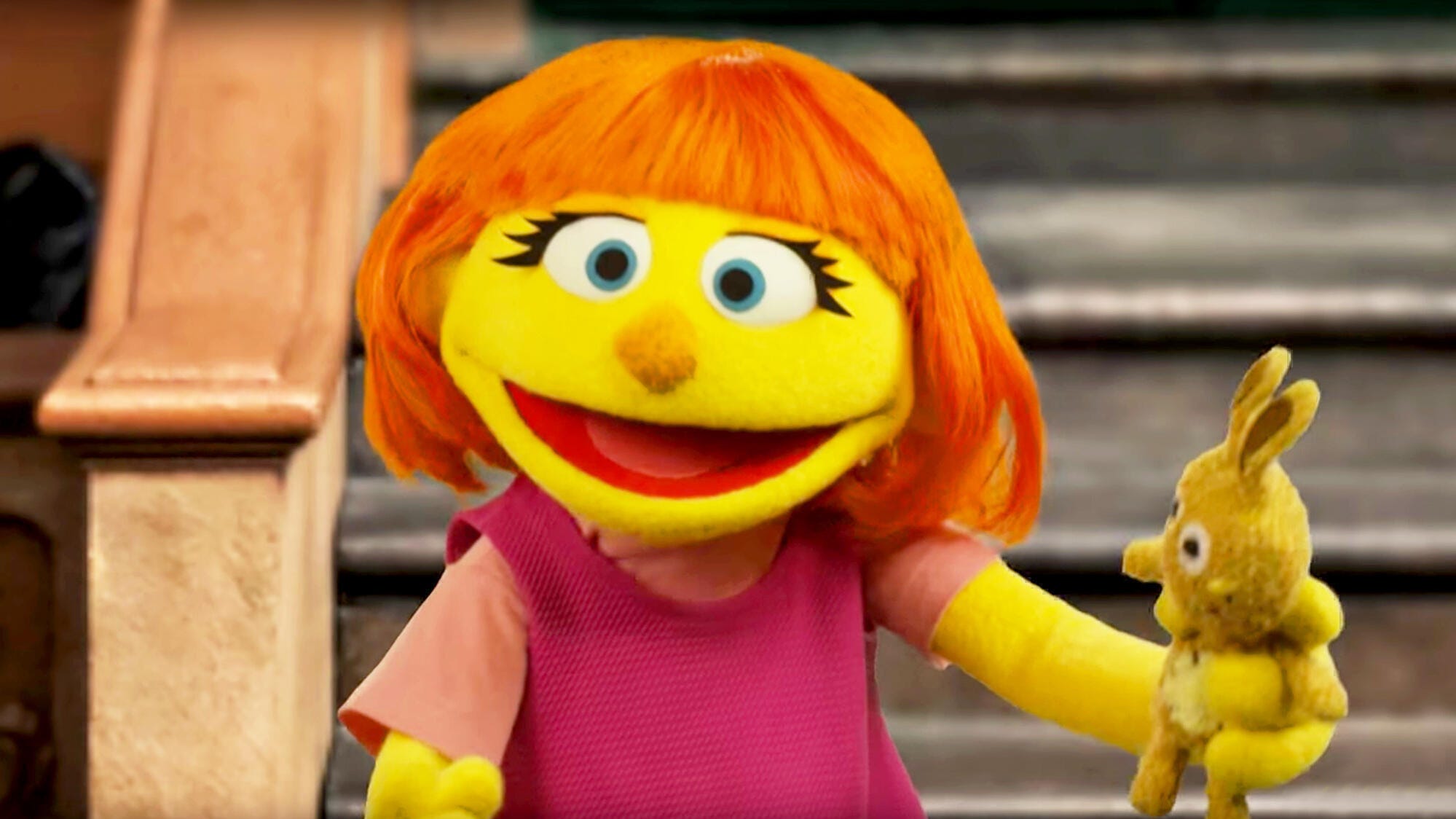
How 'Sesame Street' Teaches Kids Empathy
"The whole idea of the show, is that, if we can give kids these skills... then we feel like we're helping to create the next generation of empathetic adults."
Walking onto the set of Sesame Streetin the Astoria neighborhood of Queens, New York is like entering a portal that takes you straight back to childhood. The earliest memories for multiple generations of children include watching beloved characters like Big Bird, Elmo and Grover with rapt attention.
But in addition to the standard early childhood learning skills -- ABCs, 123s and the like -- the most important lesson Sesame Street is teaching youngsters is so subtle that even their parents might not pick up on it: empathy for those who look, sound and behave differently than them.
"Sesame Street has always had kind of a mission of diversity and inclusion," executive producer Ben Lehmann told TV Guide this spring. "Fostering empathy in young viewers, that's kind of the heart and soul of Sesame Street. ... The whole idea of the show, is that, if we can give kids these skills - whether they be around letters and numbers, which is our original mission, but also around empathy and giving preschoolers these skills around getting along with others, taking turns, learning when it's not your turn to speak but it's someone else's turn to speak, then we feel like we're helping to create the next generation of empathetic adults."
Over the years, Sesame Street has featured several characters (humans and muppets alike) of various abilities, racial and ethnic backgrounds, and socioeconomic status. In 1971, at a time when Latinos were barely represented in pop culture, and overwhelmingly relegated to background roles as maids or other service workers, the show introduced Sonia Manzano's Maria Figueroa, a Puerto Rican teenager who went on to own the Fix-It Shop and later the Laundromat with her husband Luis Rodriguez (Emilio Delgado). In the 1990s, Tarah Lynne Schaeffer joined the cast as Tarah, who was wheelchair-bound due to an autoimmune disorder. Kami, an HIV-positive muppet, made her debut on the South African version of Sesame Street in 2002.
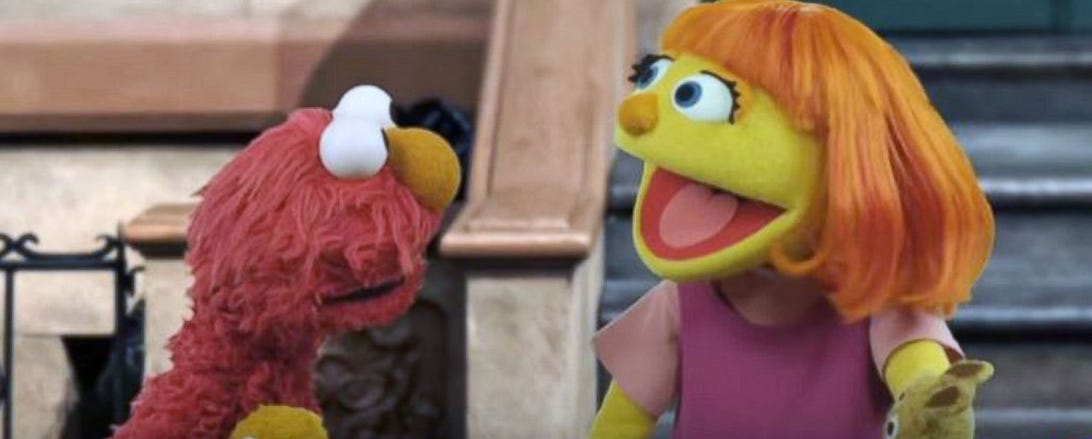
The most recent example of a Sesame Street character breaking new ground is Julia, a 4-year-old muppet who has autism. Julie was conceived by the show's Social Impact Department and introduced in a digital storybook as part of a 2015 autism initiative. She made her physical debut on the show two years later.
"The reception and feedback from people was tremendous," Lehmann says. "Autism is something that touches so many people. ... We've gotten so much feedback from parents who have children on the spectrum, how exciting this has been for them and something to share with their own kids."
As a character, Julia has many of the hallmarks of a child with autism. She rarely speaks, and when she does it's typically just a word or two, not a complete sentence. She flaps her arms when her emotions are heightened. In her premiere episode, she became overwhelmed upon hearing a siren and needed to pull away from the group to calm down.
"We've gotten a lot of letters from moms who say, 'This has happened to my kids, and I'm so proud that you guys just addressed it head-on,'" Lehmann says of the siren scene. "They especially liked that moment. It felt very real to them."
Stacey Gordon, the puppeteer who performs Julia, is herself the mother of an autistic son. However, the motivation behind incorporating Julia into Sesame Street goes beyond providing a character that autistic children and their parents can relate to. The inclusion of Julia also harkens back to Sesame Street's core mission: teaching children how to respect, get along with, and relate to people who are different from them.
Contrary to popular belief, research shows that empathy does not, in fact, come naturally to children -- especially children who are young enough to be in Sesame Street's target viewing audience, roughly 3 to 5, ages marked by a tendency towards self-centeredness. We're often told that prejudices and bullying behaviors are learned by children rather than ingrained in them, but while that may be true to an extent, children can actually be quite prone to isolating and even displaying combative behaviors towards peers who are different from them.
"Empathy can be taught," says Dr. Michele Borba, an educational psychologist and the author of UnSelfie: Why Empathetic Kids Succeed in Our All-About-Me World. "That said, there's one little disadvantage to younger children, and that is keeping in mind that empathy is 'We, not me.' That's what it really is, stepping into the shoes of somebody. Young children are egocentric by nature, and they're supposed to be. They're trying to make sense of their own world, and so a lot of things are related to 'Me, not you,' and 'What do I get from it?' But that said, our job as parents is to [guide] them beyond 'Me.' Exposing children to differences, like Sesame Street, is one of the ways to do it."
The best way to teach children empathy is by modeling or role-playing. ("Children are copycats," Borba says. "Kids learn empathy better by seeing it, not hearing about it.") Like any skill, empathy has to be practiced in order to be nurtured.
Which is where Sesame Street comes in. On the show, Julia's best friend is Elmo, who often remarks on the ways she's not like other children, but notes how much fun they have playing together and inventing games like "boing tag."
"Elmo recognizes that kids have differences, but that doesn't mean they can't do things together," Lehmann says. "That's the heart of Elmo, obviously, is he's drawn to people because he likes them. Differences, similarities, that's all part of the dimensionality of making friends."
On Sesame Street, Elmo's approach is not to ignore Julia's quirks or pretend they don't exist, but rather to acknowledge them and then adapt to them. Children watching will see that Elmo and Julia might not necessarily be able to carry on a conversation the same way he does with other characters in the neighborhood, but that doesn't mean they can't still have fun together. In one segment, Elmo teaches Julia how to play Peek-a-Boo with their favorite stuffed toys and speaks directly into the camera, telling viewers, "There's lots of ways friends can play." Among her friends, Julia's autism is free from stigma.
"Elmo and all of the group are actually portraying inclusiveness," Borba says. "I love how Big Bird will say along the way, 'That's just how she is, so what difference does it make? Let's all play together.' Which is a wonderful thing... because they're actually showing children in real time and with real kids how to be inclusive, how to be caring, how to look around and see that somebody is all by themselves, and how to say, 'Well, come on in.' That's the same thing that the puppets are doing. Very often we tell kids to be kind, but we need to show them how. ... The right TV shows can really make a difference."
In recent seasons, Sesame Street has placed a particular emphasis on depicting kindness, prompted by a 2016 Sesame Workshop survey of parents and teachers in which 86 percent of teachers and nearly 70 percent of parents described the world as "an unkind place for my child." Its 49th season, which will premiere later this year on HBO, will focus on different types of play.
The same survey posed the question, "Which is more important, having manners or having empathy?" Among parents, manners won in a landslide, 58 percent to empathy's 41. (One percent of respondents said they didn't know.)
"Empathy is timeless. The culture can either galvanize it or diminish it," Borba says. "I worry about the parents that think that it really doesn't matter."
But why is it important to raise empathetic children? For some, the answer is obvious. But according to Borba, the positive effects of fostering empathy in children go far beyond the simple desire to avoid bringing a selfish, uncaring person into the world.
"[Empathy] gives kids an enormous advantage. It gives all of us enormous advantage. It's the base of humanity," Borba tells TV Guide. "It helps children develop healthier relationships, get along better with others, have a more wide open view. They're better critical thinkers. It's just enormous."
In fact, empathy is an underrated factor in determining success later in life, perhaps more so than grades and test scores, according to Borba. It's frequently cited by business owners around the world as the No. 1 trait they're looking for in potential employees, she notes.
Perhaps the biggest challenge educators face is doing away with the labeling of empathy as a "soft skill." It's understandable that many parents would prioritize their children learning how to read, write and do basic math over being kind to one another. But as Lehmann notes, the creative minds behind Sesame Street don't believe those skill sets are mutually exclusive.
"Basically what we've done is we've created a pressure-cooker kind of society for our children, where kindness and empathy are kind of low on the scale of what really matters. It's all been about GPA, rank and score, from an early, early, age, starting at 2. We're all worried about our kids' [test] scores and that kind of a thing," Borba says. "You want to know what's going to help your child get along and be mentally healthy in the world? Empathy is at the top of the list. When it's all said and done, empathy is far more critical than we ever gave it credit for."
Empathy gives kids an enormous advantage. It gives all of us enormous advantage. It's the base of humanity.
While shows like Sesame Street are going above and beyond to teach kindness and empathy to a new generation, only some of the responsibility for doing so can fall on the shoulders of the muppets and their human counterparts. If the lessons children see on TV aren't reflected in the actions of their real-life caretakers and the other adults they see around them, they won't stick.
"I think adults are behaving very badly these days. Instead of seeing [adults] being models, [children] are seeing that bullying is OK, it's OK to name-call another person. All around," Borba laments. ... We need to tune it up in ourselves. We need to start watching and making sure we're a little more selective of what our children view."
"Parents who raise good kids, empathetic children, don't do so by accident. They're very intentional," she continues. "What you'll have is basically not just a smarter child that you're putting your time and effort into, but also a healthier, happier child. And that's what we all want together - a generation of healthy, happy kids who want to better the world."

